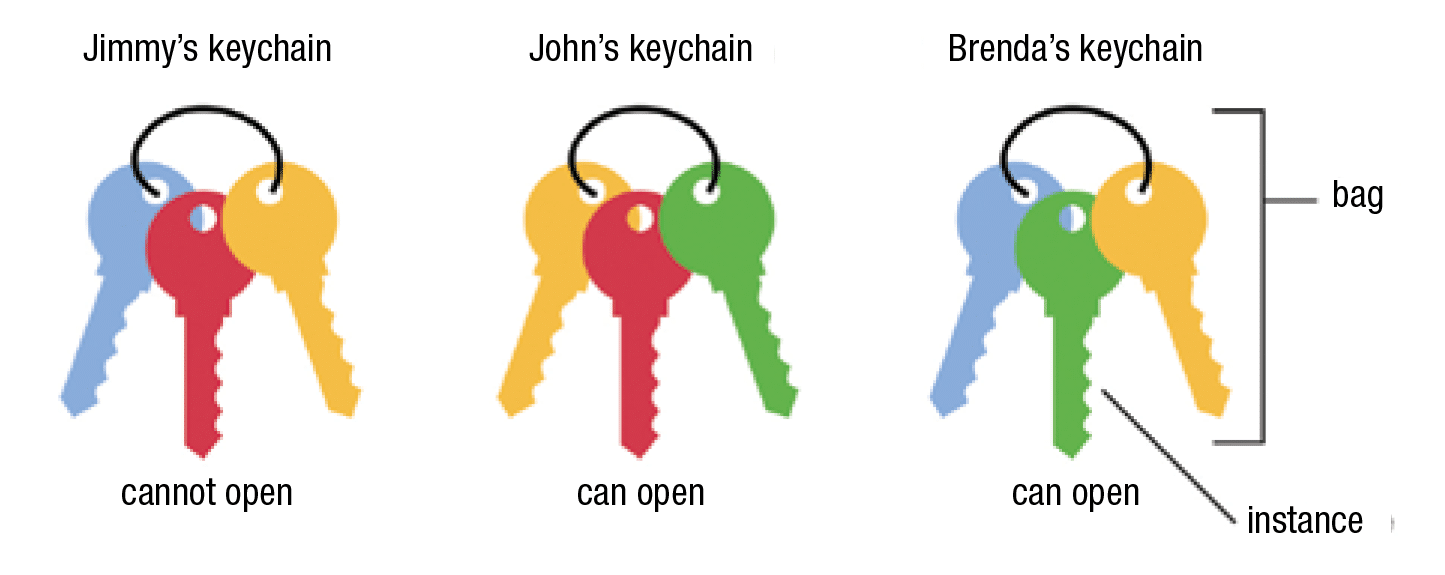A simple example is shown in the figure below. In the example, we only know whether a keychain contains the key that can open a given door. We do not have any information about the individual keys. This allows us to infer that the green key can open the door. Similarly, in medical imaging applications, an overall patient diagnosis can be a substitute for costly local annotations provided by an expert.
The MIL formulation is appropriate for computer-aided diagnoses for four main reasons:
1. Processing WSIs consisting of billions of pixels is computationally infeasible. For scale, roughly 470 pathology images contain approximately the same amount of pixels as the entire ImageNet data set.4 Therefore, it is desirable to divide each medical image into smaller tiles that can be further considered a bag with a single label.
2. Supervised approaches exist that require pixel-level annotations that outline abnormalities in a patient’s medical scan. However, these require pathologists to spend large amounts of time on data preparation, thereby interfering with their daily routines. Since MIL techniques only require weak labels (i.e. the overall diagnosis of a patient), they hold the promise of significantly reducing pathologist workloads.
3. MIL naturally fits the task of imaging-based patient diagnosis. Diseased tissue samples have both abnormal and healthy regions, while healthy tissue samples have only healthy regions. These can easily be represented as bags, each with a single label.
4. It is possible to formulate MIL as a deep-learning problem. This allows for the creation of a smooth end-to-end pipeline for pathology in which WSIs are fed in as the input and diagnoses are returned as the output. Deep MIL models can also be made to be highly interpretable, which caters to the explainability requirement of AI systems in health care discussed earlier.5
- Topol EJ. Deep Medicine: How Artificial Intelligence Can Make Healthcare Human Again. Basic Books; 2019.
- Amodei D, Hernandez D. AI and compute. OpenAI; May 16, 2018. https://openai.com/blog/ai-and-compute
- Wang D, Khosla A, Gargeya R, Irshad H, Beck AH. Deep learning for identifying metastatic breast cancer. arXiv; June 18, 2016. https://arxiv.org/abs/1606.05718
- Campanella G, Hanna MG, Geneslaw L, et al. Clinical-grade computational pathology using weakly supervised deep learning on whole slide images. Nat Med. 2019;25(8):1301–1309.
- Ilse M, Tomczak JM, Welling M. Attention-based deep multiple instance learning. arXiv; June 28, 2018. https://arxiv.org/abs/1802.04712
Mount Sinai establishes AI and human health department
The Icahn School of Medicine at Mount Sinai has launched the department of artificial intelligence and human health, with the goal of further advancing artificial intelligence to transform health care.
“The overarching goal of the department of AI and human health is to impact patients’ health with AI,” said Thomas J. Fuchs, Dsc, dean of artificial intelligence and human health at Icahn Mount Sinai, New York, in a press statement. “We will accomplish this,” he explained, “by building AI systems at scale from data representing Mount Sinai’s diverse patient population. These systems will work seamlessly across all hospitals and care units to support physicians, foster research, and, most importantly, help patient care and well-being.”
Dr. Fuchs and his team will work on integrating machine learning and AI-driven decision-making throughout the health system’s eight hospitals. This will include creating a hub-and-satellite model to make new tools and techniques available to all Mount Sinai physicians and building an infrastructure for high-performance computing and data access to improve the organization’s diagnostic and treatment capabilities.
The department will be housed in a new research facility on campus that is expected to open in late 2022.
Earlier this year, Icahn Mount Sinai announced it will offer a PhD concentration in artificial intelligence and emerging technologies in medicine as part of its PhD in biomedical sciences program, starting in the fall of 2022.
PreciseMDX releases digital shipping kits for diagnostic tests
PreciseMDX is offering digital shipping kits for at-home and on-site diagnostic tests to allow laboratories, patients, and providers to track the entire testing process and, thereby, increase efficiency.
Via the digitized process, patients scan a QR code on the shipping kit, which connects them to the laboratory and prescribing provider so that all parties are notified that testing has begun. The end-to-end solution also informs the patient that the lab received the specimen, initiating the insurance billing process, and notifies the provider and patient of the test results.
The shipping kits support a variety of diagnostic tests. PreciseMDX also provides multichannel distribution options so patients can obtain test kits in the provider office, over the counter, or via mail, vending machines, or collection and drop-off sites.
PreciseMDX, 866-462-4677
Dr. Aller practices clinical informatics in Southern California. He can be reached at raller@usc.edu. Dennis Winsten is founder of Dennis Winsten & Associates, Healthcare Systems Consultants. He can be reached at dwinsten.az@gmail.com.
 CAP TODAY Pathology/Laboratory Medicine/Laboratory Management
CAP TODAY Pathology/Laboratory Medicine/Laboratory Management
